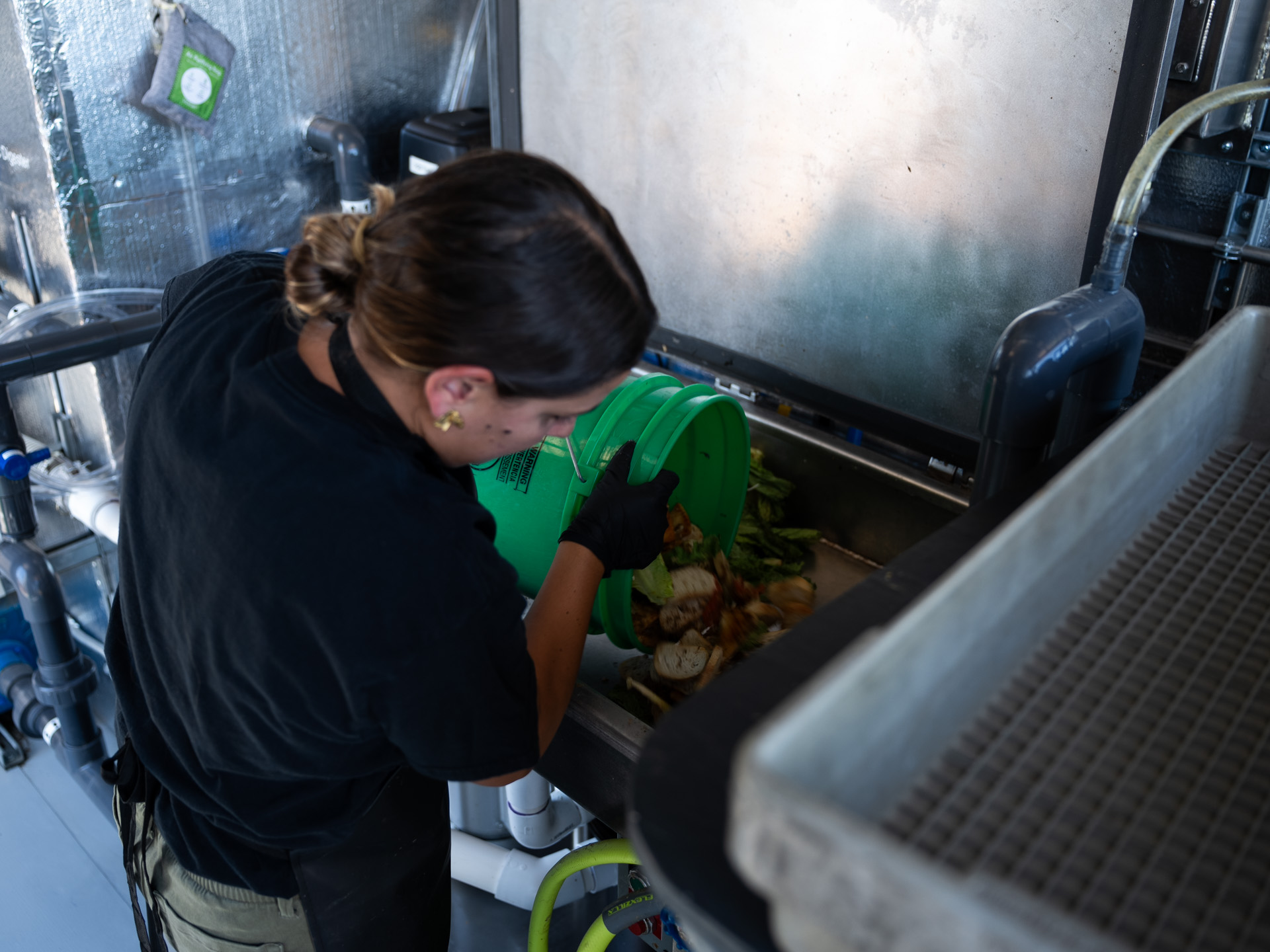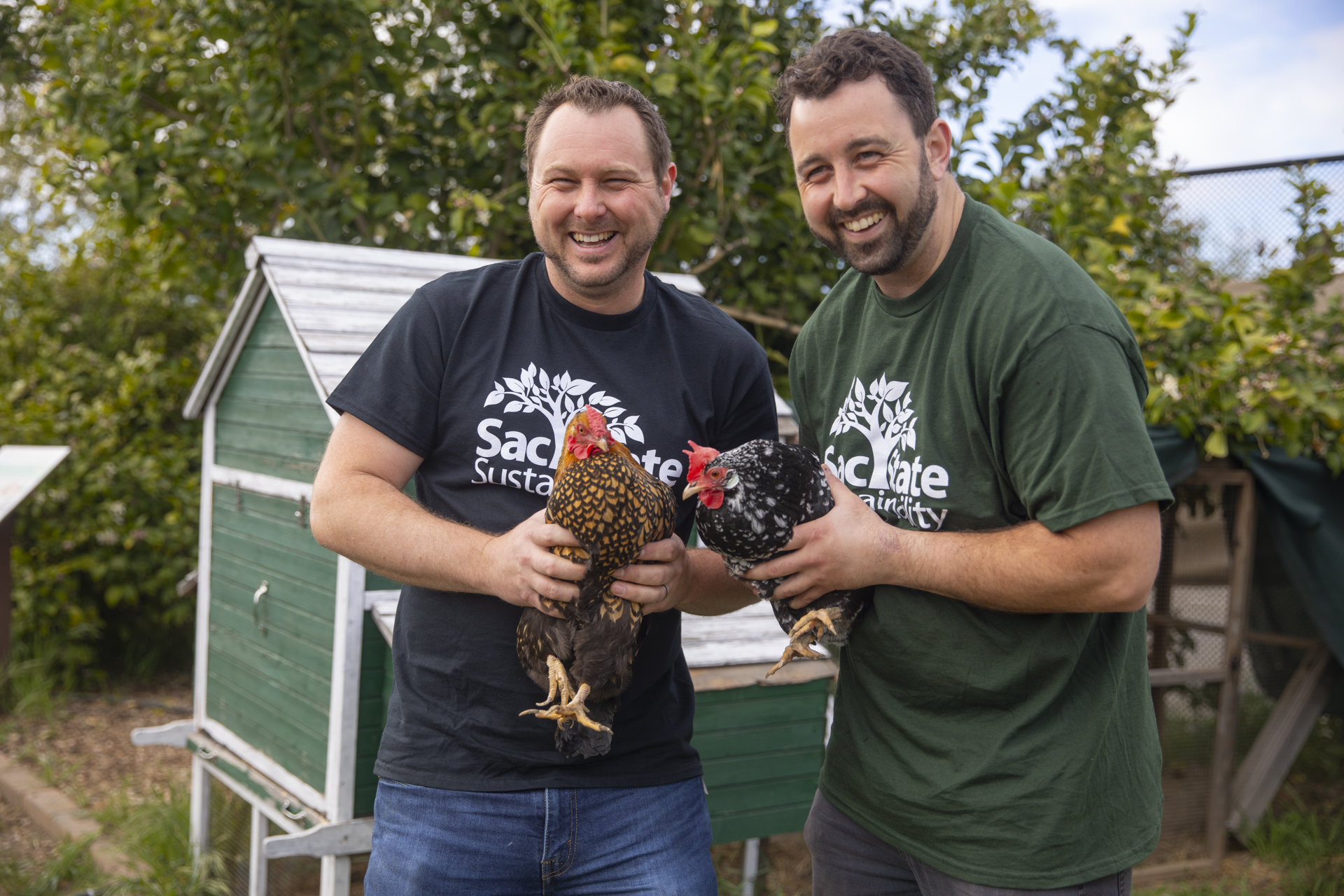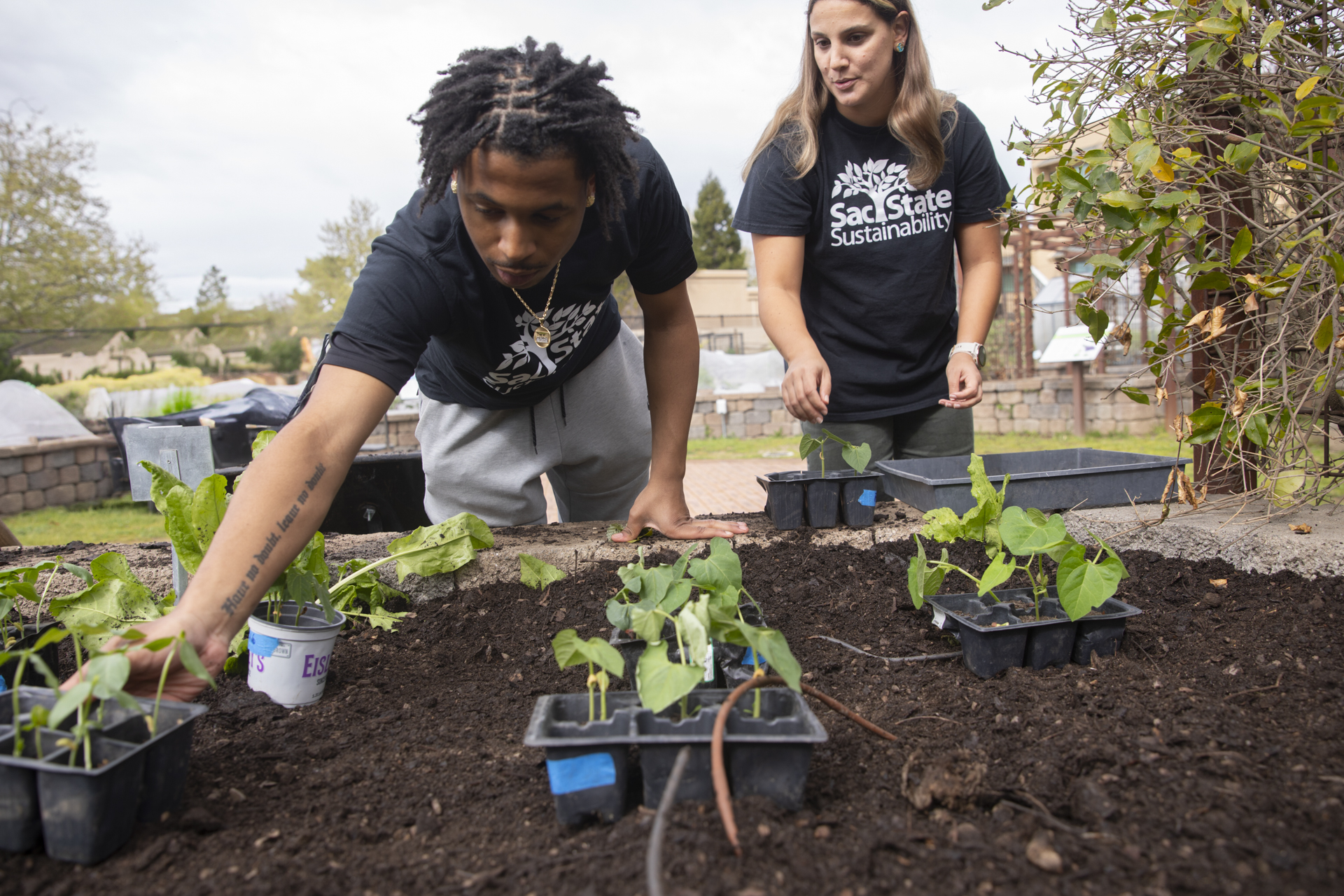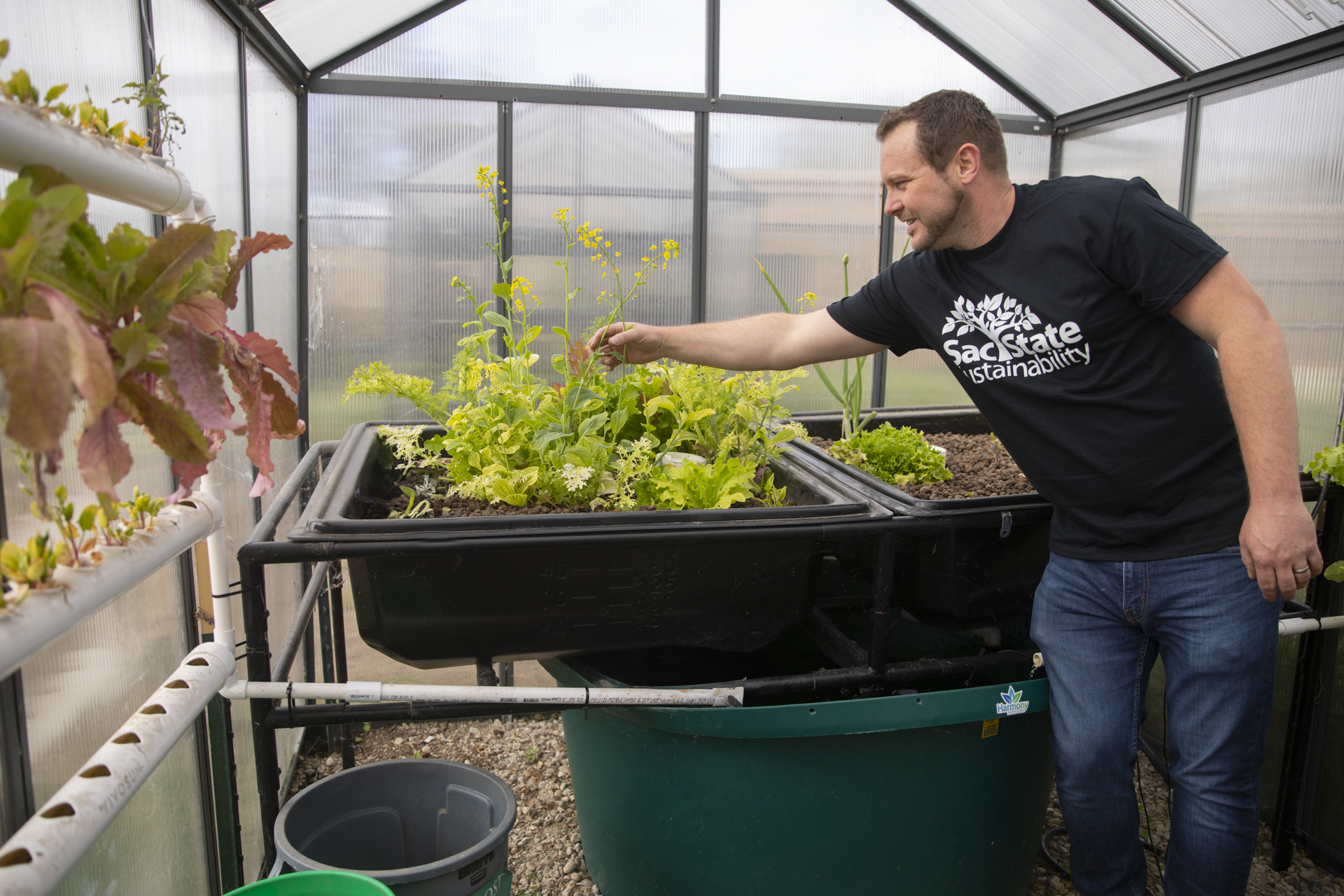Story Content
Sac State embraces a 'circle of Sustainability' as it moves closer to ambitious climate goals

April 14, 2025
When Sacramento State welcomed students and their families back to campus last fall at Nest Fest, they celebrated with Herky, cheerleaders, music, and of course, good food.
Few realized that kitchen scraps were the secret to keeping their mac and cheese melty, or that their tossed leftovers would fertilize the University’s famously green landscape as well as power future events like April’s Carnival on the Quad.
It’s all part of the circle of Sustainability at Sac State, where everything from bees in the garden to the biodigester in the BAC Yard play a vital role in a closed loop system designed to reduce the University’s impact on the environment.
In the nearly 10 years since Environmental Studies alum Ryan Todd was hired to establish the Office of Sustainability, the team has created comprehensive plans to save water and energy, eliminate waste and make Sac State a carbon neutral campus by 2040.
“I’m excited that we’ve been successful with projects that reduce energy and water use and reduce our emissions. That’s our core function. But the bigger win is being able to be more collaborative with the departments who are working in these areas on a regular basis." -- Ryan Todd, Sac State director of Energy and Sustainability
They’ve replaced faucets and lights, installed solar panels, become gardeners and beekeepers, begun composting, and maintained new stormwater drains to naturally filter toxins from runoff going into local waterways.
“The Office of Sustainability continues to lead the way in what it means to be a good steward of the environment,” President Luke Wood said. “Sacramento State has ambitious goals to be a zero-waste campus and carbon-neutral by 2040, and the innovative work by our campus community is getting us closer to those goals.”
Now Sac State is reaping the rewards.
Last summer, the California Resource Recovery Association awarded Sac State Sustainability the 2024 Outstanding Waste Prevention Award. The campus also earned its third STARS Gold rating from the Association for the Advancement of Sustainability in Higher Education with its highest-ever score.
Sacramento State also ranked in the top 100 universities in the world by the International Sustainability Green Metric rating system. Out of the 1,477 schools rated, Sac State came in at 81.
Better still, the office has won numerous grants to pay for projects such as energy-efficient lighting, water-saving faucets, native plants, an on-site composter, electric shuttles and an electric vehicle fast-charging station that can also be used by the public.
In addition to $7 million from the CSU Chancellor’s office earmarked for energy reduction projects, Sac State has received more than $2 million in state money, including two back-to-back California Department of Resources, Recycling and Recovery (CalRecycle) grants.
“I’m excited that we’ve been successful with projects that reduce energy and water use and reduce our emissions. That’s our core function,” said Todd, now the campus’s director of Energy and Sustainability. “But the bigger win is being able to be more collaborative with the departments who are working in these areas on a regular basis.
“Now they’re all thinking about the impacts of what they do and working with our team to reduce the impacts, which also reduces costs. You cut water usage, and you also cut how much you spend on water. … I don’t even have to say anything anymore. It’s created its own momentum.”
Over the years, the team’s work with other departments has ingrained sustainability goals throughout the campus.
They experimented with different LED lights before finding one the University’s electric department liked. All the old lighting is gradually being replaced, and now the top choice has become standard for all new construction. Energy-efficient design elements and materials are also included in plans for new buildings.
Todd and his Sustainability team aren’t afraid to try new ideas or gadgets.
With the goal of becoming a zero-waste campus by 2030 looming, they’ve pushed to eliminate campus refuse from ending up in landfills or local waterways. They used one of the CalRecycle grants to buy the University’s first on-site composter.
(Story continues below the image.)

Every day, roughly 400 pounds of uneaten food scraps from the Dining Commons are fed into the machine and turned into compost to fertilize the campus grounds. Leftover compost goes to local schools.
The composter, which went online in March, will divert an estimated 100 tons of food waste from the landfill over 10 years, according to Todd.
Last summer, Sac State inherited a biodigester from Cal Maritime that turns food waste into a natural, nutrient-rich fertilizer that’s better for the environment than artificial fertilizer.
It also produces methane gas that is collected and converted into electricity, which in turn is stored in portable batteries. Roughly the size of a desktop computer, these batteries can be used in place of gasoline generators to power campus events such as Nest Fest.
“We’re the only campus in the CSU system that has one, let alone two, of these types of composting technologies,” Todd said. “There’s a ton of potential for faculty to do research … and it’s also an opportunity for students who are looking to do research projects.”
Environmental Studies Professor Julian Fulton said the campus operation is a living laboratory.
“It’s this idea that we can use our campus as an incubator of ideas and opportunity for study and research,” said Fulton, who has been studying the effectiveness of Low Impact Development (LID) stormwater drains on campus. He and his students periodically collect samples of water runoff and test them for pollutants.
“There’s constantly stuff happening on campus, new projects that aren’t just static demonstrations. Their work demonstrates the process of sustainability,” he said.
“It’s really cool for students to see.”
Back in 2016, Sustainability helped an Environmental Studies student doing research for a senior thesis on ways to save water. Their study showed motion-controlled faucets would save a lot of water, and helped Sac State win a $700,000 grant to replace all the old faucets on campus.
“It shows how they support students to do research and translate that into solutions,” Fulton said.
Sustainability staff can be found doing everything from checking the hundreds of recycling and composting bins throughout campus to rescuing swarms of bees.
They not only maintain the CapRadio garden, helping grow fruits and vegetables that are given away to students at the ASI Food Pantry, they’re beekeepers, too. Their apiary program produces Hornet Honey, which is sold online.
And any given day, Sustainability staff is taking local school kids on tours of the campus, pointing out the ways Sac State tries to be a steward for the environment.
“When you talk about the effects of climate change and how detrimental it is right now, all the things that are happening in real time, it’s really important to have students think about why it’s happening and what’s being addressed.” -- Lizette Sweiven, high school teacher in the Buckeye Union School District
Lizette Sweiven recently took her high school students from the Buckeye Union School District in El Dorado County on a Sustainability tour, since they’re studying the impact humans have on the environment.
“They loved the tour,” Sweiven said. “The students were riveted and hanging on every word at every location we went to. … You can tell the staff has deep convictions about sustainability, and that it’s their life purpose. My students were really curious about their career paths.”
Sweiven said programs like Sac State Sustainability put a positive spin on what may otherwise seem like a daunting challenge to students.
“When you talk about the effects of climate change and how detrimental it is right now, all the things that are happening in real time, it’s really important to have students think about why it’s happening and what’s being addressed,” she said. “What are the solutions currently being used?
“As they become adults and move out into the world, thinking about their careers, they can ask if there’s something they can do to add to the solution or think outside of the box to create another solution.”
(Click the images below to enlarge.)
So far, the University is on track to achieve full carbon neutrality by 2040, five years ahead of California’s 2045 deadline. The campus recently added 2,886 solar panels on parking garages on top of the 3,979 that were installed in 2021.
In total, the panels generate nearly 4.25 million kilowatt hours of renewable energy every year.
Sustainability and University Transportation & Parking Services also partnered with SMUD on a grant from the California Energy Commission to build Sac State’s first Electric Vehicle fast-charging station.
Two new electric-powered Herky Shuttles, paid for by the Volkswagen Mitigation Trust, will power-up at four new fast-charging stations, which will also be open to the public to charge their electric vehicles.
Todd also recently got word that a second CalRecycle grant to install water bottle filling stations throughout campus was approved.
“What Sac State has done is really important and something to be proud of,” Sweiven said. “It leads the charge and elevates what colleges should be doing, if they aren’t already.”
More Sustainability Stories
Media Resources
Faculty/Staff Resources
Looking for a Faculty Expert?
Contact University Communications
(916) 217-8366
communications@csus.edu




